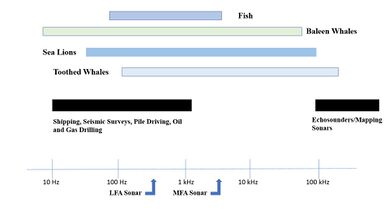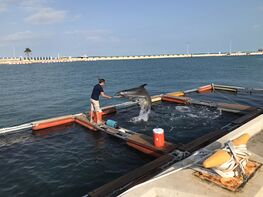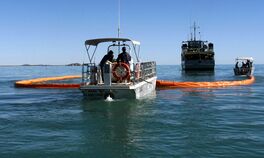Course:EOSC270/2021/Military Impacts on Marine Life
What is the problem?
How and Where it Started

The use of marine animals for military purposes began in 1959, when the United States Navy Marine Mammal Program was established[1]. In competition with the U.S. during the Cold War, the U.S.S.R also developed their own marine military program[1]. In attempts to measure the intelligence of marine mammals, the U.S. Navy has tested over nineteen marine animals to find those best suited to perform tasks that humans cannot [2]. Dolphins and sea-lions are more commonly used among the U.S Navy program and the Russian Navy than other marine animals because of their natural abilities.
How Human Actions Enforced By The Military Impact Marine Life
Direct Impacts
The major concerns of the U.S. and Russian Navy Marine Mammal Programs are the direct impacts they inflict on the marine animals they train. These marine animals are trained to detect underwater mines and to inspect and retrieve objects using their natural echolocation which locates objects by reflecting sounds [3]. To make them cooperate, extreme measures are used[4]. Militaries hold these marine animals in confined penned states and the tactics used to train animals are harsh. Due to the training and reinforcement tactics used, they become dependent on humans and other captivity patterns. If these animals are sent back into the open ocean, they could be unprepared and unable to function in the wild potentially causing issues regarding feeding, reproduction and adaptation.

Indirect Impacts
In addition to direct impacts, militaries pose indirect environmental threats to marine mammals and the ecosystem. Active sonar is a method to emit pulses of sound into the water[5]. The purpose of active sonar systems, developed by the US Navy, are to detect and track enemy vessels through generating sound waves. The sound waves emit frequencies of up to 235 db, averaging 140 db across a 300 mile radius [6]. The average sound is equivalent to a shotgun blast directly beside the ear within the 300 mile radius. The noise interference caused by the transmission of the sonar waves can disturb the foraging of some mammals. Behavioural patterns are often disrupted, and in some cases, the noise has been linked to stranded marine mammals[7]. Pursuing this further, navy vessel traffic is also an underlying contributor to the disturbance of natural underwater frequencies. Military vessels are more widely distributed than other vessels that are confined to more coastal regions[8]. Coastal ecosystems neighbouring military bases become more susceptible to damage from the traffic. Chemical spills, structural damage, noise pollution, and the introduction of invasive species are the negative impacts that trafficking of military vessels promote[9]. Marine mammals depend on sounds underwater and undisturbed natural habitats to locate and avoid predators, detect food, communicate with their species, and navigate through dark and deep waters[8]. The result of marine animals not successfully completing day to day patterns and tasks could be devastating. It may prevent mating and communication calls potentially disrupting the reproductive cycle of a species and overall population [8].
While there is a good amount of research being conducted around this topic, there is still a need for greater research to be conducted in order to find hard evidence, that will allow us to thoroughly understand these impacts on the ecosystems, and act upon them to prevent further harm.
How does this problem impact marine ecosystems?

Why Some Organisms Are More Vulnerable Than Others
Bottlenose Dolphins and California Sea Lions are amongst the organisms used most extensively in military programs. Sea Lions and Dolphins are commonly used because both are excellent swimmers with exceptional low-light vision and underwater-hearing, allowing them to track and detect underwater targets[10]. They can out-dive humans and other vessels without the risk of decompression sickness, making them important to many underwater missions[10]. Dolphins possess the most sophisticated form of sonar, a form of echolocation, allowing them to detect mines and other potentially dangerous objects on the ocean floor that are difficult to detect with human technologies[11]. These organisms thus have the ability to do almost any underwater mission, from harbour patrol and protection to rescue and recovery, making these intelligent creatures more susceptible to military use.

Direct Impacts
The military utilization of marine animals directly impacts these organisms. Military training has been found to cause physical and psychological damage to the organisms it uses[4]. Some militaries contain organisms in penned states and when re-introduced to the wild, their ability to adapt to new conditions and live independently is diminished[4]. Military training often utilizes negative reinforcement tactics, such as axing (the denying of food) and baiting (throwing fish and other foods outside their pens during training)[4]. Intended to make animals cooperative, these tactics can lead to impoverishment and nutrition depletion.
Indirect Impacts
Physical Trafficking by Military Vessels

Apart from the direct effects of this marine program, military activity also has indirect impacts on ecosystems. The frequent heavy-trafficking of marine ecosystems, such as coastal shores, by military vessels makes these ecosystems more vulnerable to damage. Ships can directly damage structures such as coral or can cause physical damage to the organisms that live there through scarring[12]. Increased vessel trafficking has increased potential to result in oil spills that can contaminate ecosystems, endangering organisms at all levels of the food web[13]. Many habitats trafficked by military vessels are vulnerable habitats for species, especially during breeding and feeding seasons[13]. This trafficking can further disrupt reproductive cycles of organisms in close proximity to military bases, further altering natural cycles of the ecosystem[13].
Military Sonar Use
The military utilization of underwater sonar causes behavioural changes for organisms in local proximity to military vessels and bases. Research has found that many organisms affected by military training were no longer able to carry out their normal functions as they would in the “wild”[14]. Military sonar has created problems for whales, dolphins, and other porpoises that live underwater and use echolocation for purposes of social communication, food foraging, and navigation. Sonar has been found to trigger behavioural changes such as the inability or abrupt stopping of foraging and vocalizing behaviours[7]. The inability to use echolocation and vocalize has been found to inhibit their responses to predation, ultimately impacting the organism’s ability to survive[7]. In some cases globally, sonar exposure has been linked to strandings of whales and porpoises[15].

What is the extent of the problem?



The Magnitude and Time Frames of Military Impacts on Marine Life
Extent of Impact on Ecosystems
While the marine mammal species used in military programs are not endangered (Bottlenose Dolphins and California Sea Lions both enjoy least-concern conservation statuses) and the scope of these programs tend to be localized, the capture and transportation of these animals involves extensive naval shipping. The acquisition and training involved can also damage at-risk marine ecosystems and harm more vulnerable species (those at greater risk of extinction). The environmental consequences of marine transportation are well documented, and are thus an indirect consequence of these programs. Marine transportation, even of military vessels, causes a variety of environmental issues. Some include air pollution, greenhouse gas emissions, introduction of aquatic invasive species, oil/chemical spills, release of cargo and garbage, underwater noise pollution, ship-strikes on marine megafauna, and sediment contamination[9]. Some species, which may be particularly important to ecosystems (such as keystone species) may be at greater threat than others. Larger animals, for example, are increasingly threatened from military marine traffic. “Marine giants” like the great whales are a few examples, as they are vulnerable to vessel traffic due to their large body size, long-range ocean movements, and needs to spend more time at the surface breathing/basking[12]. In the capture of test specimens for military testing, other animals may be caught accidentally; these live-captures are major anthropogenic mortality factors in many populations[16].

Overall, the net negative effect on the environment of Marine Mammal testing and training by militaries is pronounced.
Past and Present
Military marine mammal research and training programs had been on the decline following the end of the Cold War. Following the reduction of such programs in the 1990s, many were revamped in the 2000s and 2010s. The U.S., Ukraine, and Russia have all dedicated new resources to their programs involving marine mammals. More recently, however, military marine mammal research and training programs have been on the rise, starting with Ukraine's decision in 2011 to relaunch their dolphin and sea-lion training programs, and with Russia’s keenness to redirect the Sevastopol facility towards their own requirements. The U.S. also seems to have refocused on its Marine Mammal Program[17]. At this time, these countries are the primary proponents of military marine mammal use.


What Lies Ahead
In the future, greater naval and military investment is likely to lead to increases in the testing and training of marine mammals. Emerging military powers could establish their own marine mammal programs, resulting in a greater impact on the environment. The increasing trend in military expenditure is well documented - for example, in 2019 alone, the world's military spending had increased to 1.92 trillion U.S. dollars from 1.14 trillion U.S. dollars in 2001 (inflation adjusted)[18]. Watch this video about technological advances fueling an increase in military spending.https://www.dw.com/en/new-technologies-drive-military-spending-sipri/a-48513951
Given the impact, what are the solutions?
Solutions to Indirect Impacts of Military Activity

Different Forms of Sonar
While the impacts of naval activity on marine ecosystems are extensive and severe, there are practices which can be adopted to mitigate the harm done. Globally, navies use active sonar to detect vessels or devices in the surrounding waters despite its stress to marine life[7]. This system has alternatives which cause less harm, yet achieve similar outcomes. Passive sonar is a form of sonar which does not emit noise, rather it detects the noise coming from marine objects[19]. It is not employed often due to a lack of range detection capability, but this can be remedied using triangulation[19]. Another alternative is forward-looking sonar (FLS)[20]. This type of sonar can limit the noise it produces when mapping[20]. Both passive sonar and FLS can reduce the auditory stress on marine populations without losing key functionality of current active sonar systems.
Soft Starts in Sonar Use
If alternate sonar systems cannot be implemented, there are practices outlined by the NATO Underwater Research Center (NURC) which can be adopted to minimize active sonar harm on marine life[21]. Soft starts are a method of active sonar use which give organisms time to travel away from the affected area before any damage is done[21]. By starting the sonar at a lower intensity and higher frequency[21], organisms are alerted to the presence of a noise and leave the area. This practice is enforced in many navies around the world with great success[21].


Ship Trafficking Guidelines and Buffer Zones
There are naval practices outside of active sonar use which bring harm to marine ecosystems as well, such as the physical damages of heavy trafficking. This includes the breakage and pollution of habitats, alongside trauma to organisms. The NURC has implemented guidelines to mitigate these harms, requiring continual reports by associated navies, and external investigations into military activity in vulnerable ecosystems[21]. A successful implementation of these guidelines occurs in British Columbia (B.C.), where they mitigate the damages of the US Navy’s Northwest Training and Testing Initiative on B.C.’s coastal marine ecosystems [22]. NURC guidance also asks that navies avoid sensitive areas such as regions of breeding, feeding, or migration[21]. This practice has been successfully adopted by the Italian Navy, where they keep a large buffer zone of 5000 km around these areas [21]. Other navies, like the US Navy, have not adopted this practice as well, only keeping a buffer zone of 1 nautical mile, roughly 1.8 km[21]. Larger buffer zones reduce organismal damages, and allow for normal ecosystem function.

Solutions to Direct Impacts of Military Activity
Ethical Animal Husbandry Practices
In addition to the indirect impacts of naval activity, some navies utilize marine mammals directly in marine mammal programs. Naval marine mammal programs are often criticized for their training practices, being prompted regularly to ensure marine mammals are being trained ethically[4]. Ethical training of marine mammals is based on positive reinforcement and the establishment of trusting trainer-animal relationships, unlike negative reinforcement-based axing and baiting techniques [23]. After their service, these mammals should be rehabilitated and released to the wild if possible, along guidelines such as those of the Canadian Department of Oceans and Fisheries [24]. With updated training and release practices, militaries can ensure the physical and mental well-being of their marine mammals is maintained.

Replacement Technologies
If proper training and release practices cannot be achieved, technology can be implemented to replace marine mammal use. For example, an autonomous unmanned underwater vehicle known as the Knifefish has recently been approved for use in the US Navy[25]. It can replace the central role of dolphins in mine detection without losing efficacy[26]. By investing in updated technologies, militaries can reduce the number of physically dangerous initiatives their marine mammals undertake.
References
- ↑ 1.0 1.1 Gehrke, Charlotte. "Marine Mammals in The Military".
- ↑ Evans, William. "Historical Perspectives". Aquatic Mammals. 34 (3). doi:10.1578/AM.34.3.2008.367.
- ↑ Kaveh, A; Farhoudi, N. "A new optimization method: Dolphin echolocation". Advances in Engineering Software. 59: 53–70.
- ↑ 4.0 4.1 4.2 4.3 4.4 Mohammed, Farah (June 4 2019). "Navy Seals: Why the Military Uses Marine Mammals". JSTOR Daily. Check date values in:
|date=(help) - ↑ NOAA (2017). "What is Sonar?". National Ocean Service.
- ↑ Scientific American (2009). "Does Military Sonar Kill Marine Wildlife?".
- ↑ 7.0 7.1 7.2 7.3 Andersson, Mathias; Johansson, Torbjorn (2016). "Assessment of Marine Mammal Impact Zones for Use of Military Sonar in the Baltic Sea". Advances in Experimental Medicine and Biology. 875: 37–45. doi:10.1007/978-1-4939-2981-8_5 – via SpringerLink.
- ↑ 8.0 8.1 8.2 Firestone, Jeremy; Jarvis, Christina. "Response and Responsibility: Regulating Noise Pollution in the Marine Environment". Journal of International Wildlife Law & Policy. 10 (2): 109–152. doi:10.1080/13880290701347408.
- ↑ 9.0 9.1 Walker, T., Adebambo, O., & Feijoo, M. (2019, January 1). Environmental Effects of Marine Transportation. World Seas: An Environmental Evaluation (Second Edition) Volume III: Ecological Issues and Environmental Impacts, 3(2), 505–530.https://doi.org/10.1016/B978-0-12-805052-1.00030-9
- ↑ 10.0 10.1 Lee, Jane. "Military whales and dolphins: What do they do and who uses them?". National Geographic.
- ↑ "Naval Information Warfare Center Pacific". Naval Information Warfare Center Pacific.
- ↑ 12.0 12.1 Pirotta, V., Grech, A., Jonsen, I., Laurance, W., & Harcourt, R. (2018). Consequences of Global Shipping Traffic for Marine Giants. Frontiers in Ecology and the Environment, 17(1).https://doi.org/10.1002/fee.1987.
- ↑ 13.0 13.1 13.2 Abdulla, Ameer; Linden, Olaf. "Maritime Traffic Effects on Biodiversity in the Mediterranean Sea: Review of Impacts, Priority Areas, and Mitigation Measures" (PDF). IUCN Centre for Mediterranean Cooperation. 1: 1–170.
- ↑ "Does Military Sonar Kill Marine Wildlife?". Scientific American. June 10 2009. Check date values in:
|date=(help) - ↑ Barcenas-De la Cruz, Daniela; DeRango, Eugene; Johnson, Shawn; Simeone, Claire (2017). "Evidence of anthropogenic trauma in marine mammals stranded along the central California coast, 2003–2015". Marine Mammal Science. 34: 330–346 – via Wiley Online Library.
- ↑ Lien, J. (1999). A review of live-capture and captivity of marine mammals in Canada. A Review of Live-Capture and Captivity of Marine Mammals in Canada, 1(1), 7. https://waves-vagues.dfo-mpo.gc.ca/Library/274675.pdf
- ↑ Macdonald, J. (2015, August 3). Marine Mammals in the Military. Scuba Diver Life. https://scubadiverlife.com/marine-mammals-military/
- ↑ Statista. (2020, December 1). Military expenditure - worldwide trend 2001 to 2019. https://www.statista.com/statistics/264434/trend-of-global-military-spending/.
- ↑ 19.0 19.1 US Department of Commerce; N. O. A. A (June 1 2013). "What is Sonar". National Ocean Service. Check date values in:
|date=(help) - ↑ 20.0 20.1 Loggins, C.D. (2001). "A comparison of forward-looking sonar design alternatives". An Ocean Odyssey. Institute of Electrical and Electronic Engineers. 3: 1536–1545. doi:10.1109/OCEANS.2001.968061.
- ↑ 21.0 21.1 21.2 21.3 21.4 21.5 21.6 21.7 Dolman, Sarah; Weir, Caroline; Jasny, Michael (2009). "Comparative review of marine mammal guidance implemented during naval exercises". Marine Pollution Bulletin. 58 (4): 465–477. doi:https://doi.org/10.1016/j.marpolbul.2008.11.013 Check
|doi=value (help) – via Elsevier ScienceDirect. - ↑ United States Pacific Fleet (2020). "Northwest Training and Testing Activities Final Supplemental Environmental Impact Statement (EIS)". Northwest Training and Testing Environmental Impact Statement.
- ↑ Brando, Sabrina (January 2010). "Advances in Husbandry Training in Marine Mammals Care Programs". Journal of Comparative Psychology. 23 (4): 777–791 – via eScholarship.
- ↑ Ocean Wise (2020). "We Give Marine Mammals A Second Chance At Life - Ocean Wise: Marine Mammal Rescue". Ocean Wise | Marine Mammal Rescue.
- ↑ U.S. Department of Defense (July 20 2020). "Contracts for July 20, 2020". U.S. Department of Defense. Check date values in:
|date=(help) - ↑ Eckstein, Megan (April 30 2012). "Joins LCS MCM package in 2019: Knifefish To Provide Buried Mine Detection, Classification Capability". Inside the Navy. 25 (17): 1, 12–13 – via JSTOR. Check date values in:
|date=(help)